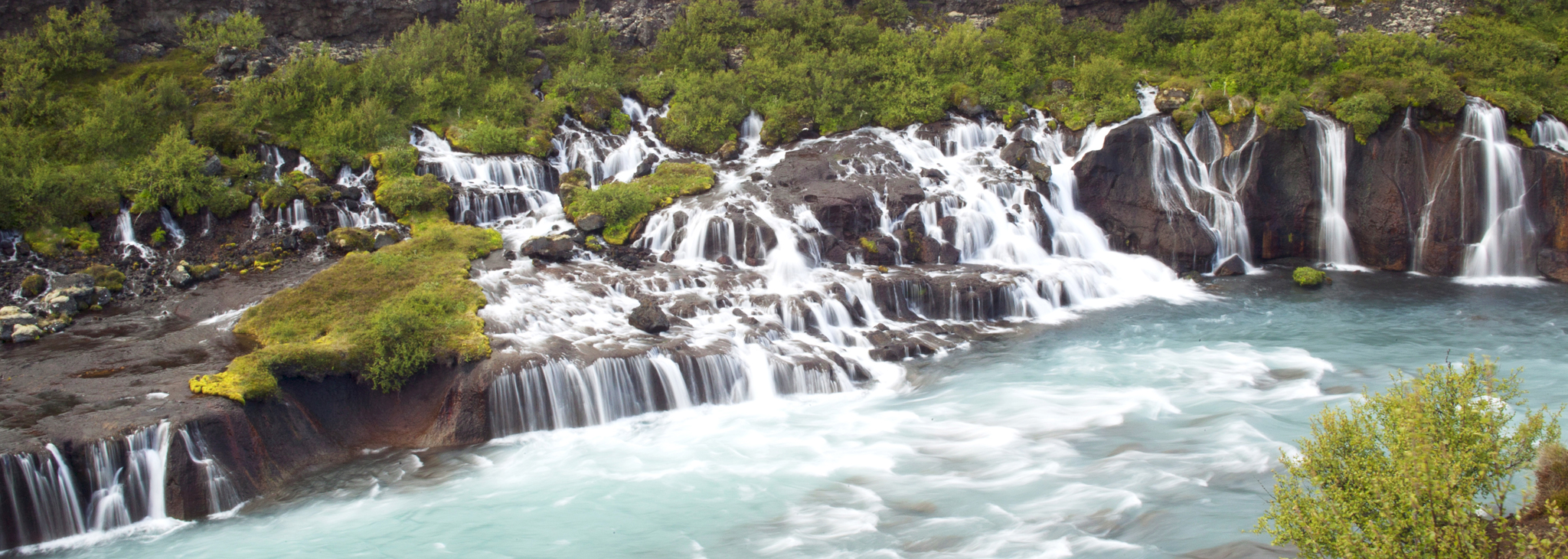WATERFALLS

1. Hraunfossar and Barnafoss
Two adjacent falls, with very different characters, can be found within easy reach of Borgarnes on the west coast. At Hraunfossar, blue water splashes out from under a lush moss-covered lava bank and gurgles down into the river, while Barnafoss forms a short, savage set of rapids as it cuts through a narrow canyon just upstream.

Water splashing from under the moss-covered lava bank, Hraunfossar
2. Glymur
Iceland’s tallest waterfall, Glymur drops nearly 200 m (658 ft) off the top of a plateau inland from Hvalfjörður, along the west coast. Legend has it that a mythical beast, half-man and half-whale, swam up the waterfall and into Hvalvatn, the lake at the top – where whale bones have indeed been found.
3. Gullfoss
This large, beautiful and always impressive two-tier fall (see Gullfoss) sits on the Hvítá river around 75 km (47 miles) northeast of Reykjavík. It is one of Iceland’s most visited sights, along with nearby Geysir and Þingvellir. In the early 20th century, it was at the heart of the country’s first environmental dispute.
4. Seljalandsfoss
Fed by the melting water from Eyjafjallajökull icecap, Seljalandsfoss is narrow and not especially tall, but it drops into a meadow along the south coast with surprising force. Adventurous visitors can take a walk along the path behind the water curtain, for a good soak. Look out for several smaller falls nearby.
5. Dettifoss
Europe’s biggest waterfall in terms of volume, this monster at Jökulsárgljúfur National Park can be heard miles away. The stark setting, where the river drops 45 m (148 ft) between the shattered cliffs of the Jökulsá canyon, adds to the spectacle. Upstream is another waterfall, Selfoss, only 10 m (33 ft) high but 70 m (230 ft) across.
6. Skógafoss
Just walking up along the river to this mighty waterfall is an incredible experience: as you approach, the flat gravel plain vanishes inside soaking clouds of spray and an extraordinary level of noise. Climb a staircase up to the top for more cascades and views out over southern Iceland’s coastline.

The cascades of Skógafoss
7. Dynjandi
This waterfall in the Westfjords near Hrafnseyri cascades over several tiers of basalt boulders in a 60-m- (198-ft-) wide, 100-m (329-ft) drop. Crashing over all those boulders gives Dynjandi (“the Thunderer”) its name, but views seawards over grassy dales make it a beautiful place to camp out.
8. Goðafoss
Located between Akureyri and Mývatn, this “Waterfall of the Gods” is where the 10th-century Law-speaker Þorgeir Ljósvetningagoði, who championed the introduction of Christianity to Iceland, disposed of the statues of pagan Norse gods in the year 1000. The ice-blue water channels over several falls, with easy walking tracks between them.
9. Ófærufoss
This waterfall thunders into the Eldgjá canyon on the Fjallabak Route between Landmannalaugar and Skaftafell. The river flows along the top and drops into the canyon, gouging out a broad, scree-ridden pool before falling again as a smaller curtain onto the plain.
10. Aldeyjarfoss
Off the northern end of the rugged Sprengisandur Route across Iceland’s Interior, Aldeyjarfoss cuts a rough scar across the huge Suðurárhraun lava field, exposing layers of ash and rock that have settled over successive eruptions. Although only 20 m (66 ft) high, the falls are very forceful and electrify an otherwise lifeless terrain.

Aldeyjarfoss, at the north end of the Sprengisandur Route


